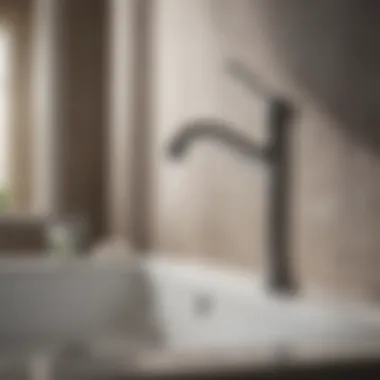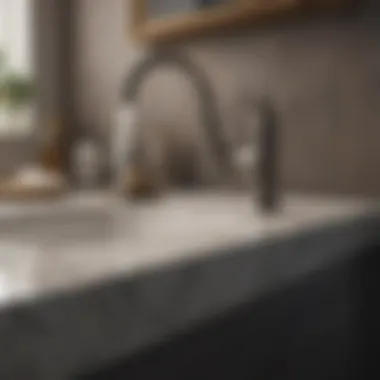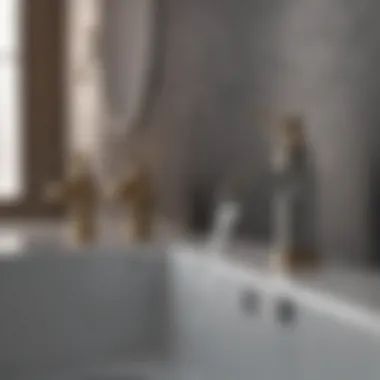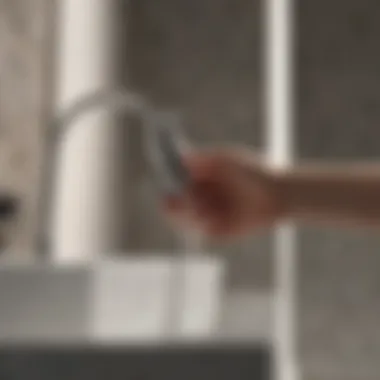Expert Guide to Changing Your Bathroom Faucet


Intro
Changing a bathroom faucet can greatly affect the overall appearance and functionality of this vital space. It is not only about aesthetics but also about improving the efficiency of water usage and reducing potential leaks. This article aims to provide a detailed examination of the faucet replacement process, offering practical advice and comprehensive insights necessary for this undertaking.
The journey begins with understanding the current trends in faucet design and how they can reflect personal style. This guide will delve into the prevalent styles and color palettes that homeowners often choose. Additionally, we will explore the essential tools required, step-by-step instructions for replacing a faucet, and tips for selecting the right model. By addressing potential challenges that might arise during installation, as well as maintenance practices for longevity, this guide is crafted to assist you through each phase of your project.
Whether you seek to improve the functionality of your bathroom or elevate its visual appeal, this article serves as a roadmap for transforming your space.
Understanding the Need to Change Your Bathroom Faucet
Replacing your bathroom faucet can significantly improve not only the functionality of your sink but also the overall aesthetic appeal of your bathroom. A faucet is an essential fixture, and over time, it can wear down or become outdated. Understanding why it is necessary to change your bathroom faucet can lead to better decisions and long-term satisfaction.
A faulty faucet can result in various problems and inconveniences. Homeowners may face leaks, increased water bills, and diminished water pressure, which can frustrate daily routines. Recognizing the signs of wear and tear is crucial in avoiding potential water damage and ensuring that your bathroom remains a functional space.
Additionally, an upgrade provides an opportunity to refresh the ambiance of your bathroom. Modern designs are available that can align better with current trends or personal style. This is especially important in a space where individuals spend time preparing for their day.
The benefits of changing your faucet include enhanced water efficiency, an updated look, and improved durability. Investing in a new faucet often pays off through lower utility costs and a more pleasing home environment.
Signs of Faucet Wear and Tear
Leakage issues
Leakage is one of the most common signs that your faucet needs attention. Minor leaks may seem negligible, but they can lead to larger issues over time. Water constantly dripping can increase your water bill and contribute to mold growth underneath the sink.
Key Characteristics: A leaky faucet typically reveals itself through visible water stains or dampness around the sink area.
Benefits: Addressing leaks promptly can avoid further damages and costly repairs, promoting a healthier bathroom environment.
Difficulty in turning the handle
If you notice increasing difficulty when turning the faucet handle, it indicates wear in the internal mechanisms. This issue commonly arises due to mineral build-up or internal component wear. Key Characteristics: A sticky or squeaky operation while turning the faucet can be an early warning sign. Benefits: Ensuring that the handles operate smoothly enhances user experience and indicates that other parts may also need checking.
Low water pressure
Experiencing low water pressure can be frustrating. This issue may not only relate to the faucet but could be a symptom of clogs or issues within pipes.
Key Characteristics: Persistent low pressure indicates underlying problems needing attention.
Benefits: By addressing low water pressure, you ensure a more functional bathroom that makes daily tasks easier.
Upgrading Your Bathroom Decor
Choosing modern designs
Modern faucet designs offer more than just visual appeal; they can also enhance functionality and water efficiency. Many contemporary models include features like pull-down sprayers or touchless activation.
Key Characteristics: Sleek lines and innovative technology define modern designs, making the bathroom look more updated.
Benefits: These designs make daily tasks easier and can lead to energy savings through better water management.
Color and finish considerations
The choice of color and finish can dramatically impact your bathroom's overall look. Popular choices include chrome, nickel, and oil-rubbed bronze, each offering distinct aesthetics and durability.
Key Characteristics: Finishes can set the tone of your bathroom, influencing light reflection and overall mood.
Benefits: Matching your faucet finish to other fixtures creates a cohesive design, a subtle but essential upgrade to your space.
Compatibility with existing fixtures
Selecting a faucet that easily integrates with current fixtures is crucial for a seamless update. Understanding your existing plumbing and layout can prevent unnecessary complications.
Key Characteristics: The size and type of connections matter for installation.
Benefits: Ensuring compatibility reduces the risk of additional costs or labor during installation, providing a hassle-free experience.
Tools Required for Faucet Replacement
Changing your bathroom faucet is not just about picking the right model and style. It also requires an understanding of the tools essential for the job. Having the proper tools can make the process efficient and ensure the installation is done correctly. Using inadequate tools may lead to complications, resulting in wasted time, effort, and even possible damage to your plumbing systems.
This section will cover the basic plumbing tools you will need, as well as safety equipment to consider before starting your project.
Basic Plumbing Tools
Wrench and pliers
A good quality wrench and pliers are fundamental tools for any plumbing project. They are essential for gripping, twisting, and turning nuts and bolts that may be hard to reach or remove. A wrench, especially a basin wrench, provides the leverage needed to break loose stubborn fittings.
The versatility of pliers adds convenience, allowing you to tackle various tasks with ease.
One key characteristic of these tools is their grip. A wrench fits properly over fasteners, while pliers allow for a more tactile hold on different shapes. They provide the advantage of increased control, especially in cramped spaces, which is often the case in bathrooms.
However, using these tools requires a bit of practice to avoid damaging fixtures or causing personal injury.
Screwdriver types


Various types of screwdrivers are crucial for removing and securing screws during the faucet installation. A flathead and Phillips screwdriver are typically required for most faucet types. Each screwdriver fits different screw heads, making it important to have both types on hand.
The key characteristic of screwdrivers lies in their heads; they must match the screw type you are dealing with. This selection can significantly reduce the chances of stripping the screws, a common issue faced during installation. Having the right screwdriver can save you time and frustration. However, if you do not maintain them, they may become ineffective over time.
Plumber's tape
Plumber's tape, also known as Teflon tape, is a thin, white tape used to seal pipe threads. It prevents leaks by creating a barrier that helps close gaps between threaded connections. Utilizing plumber's tape is essential whenever you connect new plumbing components.
A key feature of plumber's tape is its ability to withstand various temperatures and conditions. This characteristic makes it ideal for use with both hot and cold water systems. Properly applying the tape provides durability and reduces the need to tighten fittings excessively, which could lead to damage. Yet, using too much tape can cause improper sealing or even break fittings, making it essential to apply it correctly.
Safety Equipment
Gloves
Gloves are a simple yet effective way to protect your hands during the installation process. They can guard against potential cuts, scrapes, and chemical exposure from rust removers or cleaning supplies. Wearing gloves enhances grip, allowing you to handle tools and parts with greater security.
The right pair of gloves can be made from latex, rubber, or specialized materials that resist chemicals. The beneficial aspect of using gloves is that they prevent you from coming into contact with sharp objects and dirty surfaces. However, wearing the wrong type can limit your dexterity, making tasks more difficult.
Safety goggles
Safety goggles protect your eyes from debris and splashes that may occur during removal or installation. They are especially important when dealing with older fixtures that may have accumulated corrosion or mineral deposits.
The characteristic that makes safety goggles essential is their protective seal around the eyes, preventing any unwanted particles from entering. They are a smart choice for maintaining safety in home improvement projects. Although goggles may not always be necessary, they provide peace of mind and should be considered whenever working on plumbing tasks.
Selecting the Right Bathroom Faucet
Selecting the right bathroom faucet is crucial for both functionality and aesthetics in your renovation or upgrade project. A well-chosen faucet can improve the user experience, enhance the overall design, and even increase the value of the bathroom. It is worth spending time to understand the various types, materials, and finishes available. When selecting a faucet, consider the style of your bathroom, the ease of use, and the specific requirements of your plumbing.
Types of Faucets Available
Single-handle faucets
Single-handle faucets provide a simple solution for controlling water flow and temperature. This design is often favored due to its ease of use, allowing a user to adjust both aspects with one hand. This is particularly beneficial in a busy household where quick operation is needed.
A key characteristic of single-handle faucets is their minimalist design. They take up less space and can fit in various environments. They are also easier to install than more complex options. One disadvantage could be that they may not offer the same precise control over temperature as dual-handle types.
Dual-handle faucets
Dual-handle faucets offer separate controls for hot and cold water. This feature allows for more fine-tuned adjustments. Many people appreciate the traditional look of dual-handle faucets, often used in classic or vintage styled bathrooms.
The primary benefit of dual-handle faucets is the control they provide; users can easily find the perfect balance of temperatures. However, they require both hands to use, which could be inconvenient. Additionally, installations can be slightly more complex, requiring more time and effort.
Wall-mounted faucets
Wall-mounted faucets are installed directly on the wall above the sink. This option creates a unique aesthetic appearance while providing a contemporary and clean design. They often give an impression of space, as they free up counter space around the sink area.
Their key characteristic lies in the external plumbing visibility, which is part of their design appeal. They are highly functional and can also be easier to clean around, as there are no bases or fixtures on the counter. However, installation may involve more significant plumbing modifications and complexities.
Material and Finish Choices
Choosing the right material and finish is as important as selecting the type of faucet. The material affects durability, maintenance, and appearance, while the finish ensures the faucet integrates seamlessly into your design aesthetic.
Stainless steel
Stainless steel faucets are known for their durability and modern appeal. They resist rust and corrosion well, making them suitable for high moisture environments like bathrooms. This material is often lightweight, which also makes installation easier.
Its main advantage is low maintenance. Stainless steel requires only regular cleaning to keep its shine. A potential downside, however, is that it can show fingerprints and water spots more easily compared to other finishes, which may require more frequent cleaning.
Bronze
Bronze faucets provide a rich, earthy look that can give a sophisticated touch to any bathroom. They often come with a unique patina that enhances their appeal. Bronze is less prone to corrosion than other metals, which translates to longevity and durability.
The key characteristic of bronze is its ability to add a warm feel to the space. However, they may require special cleaning methods to maintain their finish, and they can be more expensive than other options.


Chrome finishes
Chrome faucets are extremely popular for their sleek, shiny appearance. They add a modern touch to bathrooms and can fit with various styles. Chrome is resistant to corrosion and scratches, making it an ideal choice for busy households.
One major advantage of chrome finishes is their easy maintenance. A quick wipe down is usually all that is needed to keep it looking new. However, they can be susceptible to water spots and fingerprints, which might detract from their appearance.
Step-by-Step Guide to Changing a Bathroom Faucet
Changing a bathroom faucet is a task that can enhance both the functionality and aesthetic appeal of your bathroom. A clear step-by-step guide ensures that the process is smooth, reducing the likelihood of mistakes and making the work manageable for anyone, regardless of skill level. Following structured steps can also save time and prevent unnecessary frustration. When the right approach is taken, this task can easily elevate the bathroom experience.
Preparation Before Installation
Preparation is key to a successful faucet replacement. Each step here lays the groundwork for a smoother installation process.
Shutting off the water supply
Shutting off the water supply is the first crucial step. This action prevents unexpected water flow during the replacement process, which could lead to significant mess and complications. It is essential to locate the water valves, usually found under the sink, and ensure they are fully turned off. This step is beneficial because it safeguards your home from water damage, which can be costly to repair.
The unique feature of shutting off the water supply is its simplicity. It requires minimal effort but yields substantial protective benefits. Not taking this step could result in water shooting out, making a simple replacement turn into an urgent repair.
Gathering necessary tools
Gathering necessary tools before starting the replacement task is essential. Tools such as a wrench, pliers, and various screwdrivers are required to successfully complete the installation. This step contributes to an organized and efficient workflow. Having everything within reach minimizes interruptions, allowing you to focus on the task at hand.
A key characteristic of gathering tools is that it ensures you are prepared for unforeseen challenges that may arise during the installation. This proactive measure allows for a smoother process. However, neglecting this step could lead to interruptions, potentially making the task take much longer than needed.
Reading manufacturer instructions
Reading manufacturer instructions before beginning emphasizes the importance of specific details unique to your faucet model. Each faucet can have different installation requirements. Understanding these instructions helps to avoid potential mistakes that could prolong the installation or affect the faucet's performance.
A distinctive aspect of reading these instructions is that it shows adherence to the guidance provided by the manufacturer, which is crucial for warranty purposes. Failure to comply can result in voided warranties and added costs in case of damages or defects. Thus, taking the time to comprehend these details is worthwhile and necessary.
Removing the Old Faucet
The removal of the old faucet is an integral part of the faucet replacement process. This step often involves dismantling several components, requiring a methodical approach.
Disconnecting water lines
Disconnecting water lines is an essential task that allows for the removal of the old faucet. Care should be taken to ensure that any residual water drains before proceeding. This step is crucial for avoiding spills and maintaining a clean working area.
The main advantage of disconnecting water lines effectively is that it clears the way for the installation of the new faucet without interference. Failing to disconnect properly could lead to damage to the plumbing or lingering water, complicating the installation.
Unscrewing mounting hardware
Unscrewing mounting hardware is a straightforward yet necessary task. This involves removing the various screws and bolts that hold the faucet in place. It's vital to keep track of these components so that reinstalling them can be done smoothly with the new faucet.
The benefit of paying attention to unscrewing the hardware means that you ensure each piece is handled properly, avoiding loss or damage. Neglecting this part of the process may result in challenges when trying to attach the new faucet correctly, potentially leading to an incomplete installation.
Removing the faucet assembly
Removing the faucet assembly is the final step in detaching the old faucet. Ensuring that all old parts are cleared away helps prepare for a seamless installation of the new faucet. This step contributes to a clean environment and sets the stage for upgrading your bathroom.
The uniqueness of this action lies in its impact; it allows for a fresh start with your new faucet. Holding on to any old parts inadvertently might confuse future installation efforts and lead to inefficiencies. Therefore, thorough removal is essential.
Installing the New Faucet
The actual installation of the new faucet brings the project to its culmination. Attention to detail at this stage ensures both functionality and appeal.
Placing the new faucet
Placing the new faucet accurately is an essential step. This installation requires aligning the faucet correctly with existing holes to ensure a proper fit. This process often determines the aesthetic appeal of your new faucet.


The key characteristic of careful placement is its direct influence on both function and appearance. A misalignment can lead to leaks and aesthetic problems. Therefore, it’s beneficial to take this step seriously, as it affects both immediate function and long-term satisfaction with your installation.
Connecting water supply lines
Connecting water supply requires precision, as it involves attaching the faucet to the ongoing water lines. It’s important to ensure that all connections are secure to prevent future leaks. This step is crucial because leaks can cause damage over time, making an initially successful installation problematic.
A unique aspect is that this step demands careful examination of connections. Properly connecting these lines can lead to a hassle-free operation of the faucet. Neglecting this can result in leaks, which could negate the efforts put forth in previous steps.
Testing for leaks
Testing for leaks is the final quality control step after installation. This process typically involves running both hot and cold water to check for any signs of water escaping from newly connected lines. Identifying leaks early can save you from extensive damage and costly repairs later.
The characteristic of this step is its preventative nature. By taking the time to test, you can ensure that your new faucet performs without unexpected failures. Ignoring this aspect can lead to enduring problems, minimizing the value of all previous work invested in the project.
Troubleshooting Common Issues
When changing a bathroom faucet, it's not uncommon to encounter certain challenges. Troubleshooting common issues is an integral part of ensuring that the faucet operates smoothly after installation. Addressing problems like leakage and low water pressure can significantly enhance user experience and prolong the faucet's lifespan. Recognizing and rectifying these issues early on can prevent further complications and unnecessary repairs. Therefore, understanding these troubleshooting steps is crucial for a successful faucet replacement.
Dealing with Leakage
Leakage can occur from various points in the faucet assembly. Identifying the source of the leak is essential.
Identifying source of leak
Identifying the source of a leak is key in maintaining a properly functioning faucet. Common leak points like the base, handle, and connections often require investigation. The first step is to visually inspect these areas. This examination reveals if water is dripping from any joint or seal. The key characteristic of this step is its potential to save both time and money, as pinpointing the leak directly leads to more targeted repairs. Understanding where the leak originates allows for better decision-making regarding repairs or part replacements. Consideration should be given to how often this step might need to be repeated, given general wear and tear on faucets over time, especially in older homes.
Correcting loose connections
Correcting loose connections can also directly address leaking issues. Through simple adjustments, homeowners can often resolve leaks without needing to replace entire components. A common characteristic associated with this is the ease of access to most faucet connections. Looseness can easily develop over time due to thermal expansion and regular use. By carefully tightening these connections, the risk of further leakage drops significantly. This approach requires minimal tools and can often be performed without the help of a professional. However, care must be taken not to over-tighten, as that could lead to different problems down the line.
Handling Low Water Pressure Post-installation
Low water pressure is another issue that can arise post-installation. After replacing the faucet, a significant drop in pressure can be frustrating.
Checking aerator for clogs
Checking the aerator for clogs is a practical step toward resolving low water pressure. Aerators, often located at the end of the faucet spout, can accumulate mineral buildup over time. This buildup restricts water flow, leading to diminished pressure. Inspecting the aerator involves unscrewing it and cleaning or replacing it as necessary. This step is beneficial because it often resolves issues without necessitating more extensive plumbing adjustments. Given the ease of access and the affordable cost of replacements, addressing aerator clogs should be among the first troubleshooting steps taken after a new faucet installation.
Inspecting supply lines
Inspecting supply lines provides another avenue for addressing low water pressure. These lines are responsible for delivering water to the faucet. If they are kinked, damaged, or blocked, pressure can suffer. The characteristic of this step is its focus on the hardware behind the faucet, which often gets overlooked. Clearing any obstructions here is vital for ensuring optimal function of the faucet. Homeowners should regularly inspect these lines especially after installing new faucets, as improper installation can sometimes lead to pressure issues. Despite being a more involved process than checking the aerator, taking the time to do so can lead to far more consistent water flow.
Post-Installation Maintenance Tips
After successfully changing your bathroom faucet, it is vital to ensure its longevity and optimal performance through maintenance. Regular care not only enhances the aesthetic of your bathroom but also prevents future plumbing issues. Maintenance tips contribute to the faucet's operational efficiency, saving you from expensive repairs later. Additionally, proper maintenance significantly extends the lifespan of your faucet, safeguarding your investment.
Regular Cleaning Recommendations
Appropriate cleaning supplies
Choosing the correct cleaning supplies is essential for maintaining a bathroom faucet. The use of mild soaps or specific faucet cleaners is advisable. These products effectively remove dirt and grime without damaging the faucet's surface. Their neutral pH ensures that the finish remains intact, preserving its appearance. Some cleaners include anti-bacterial properties, promoting a healthier environment in your bathroom. It's worth noting that using proper cleaning supplies can prevent buildup, which might cause faucets to work inefficiently over time.
Avoiding harsh chemicals
Avoiding harsh chemicals is crucial to protect the integrity of your newly installed faucet. Strong cleaning agents can mar the finish, leading to scratches and discoloration. These chemicals often contain abrasive particles that can wear down the surface quickly. Selecting gentle cleansers not only minimizes this risk but also ensures a safer application, particularly in households with children or pets. This careful approach maintains the faucet’s aesthetic and functional quality well into the future.
Periodic Maintenance Checks
Inspecting seals and washers
Inspecting seals and washers should be part of your periodic maintenance routine. These components are essential in preventing leaks and maintaining proper water flow. Regular checks can reveal wear and tear early on, allowing for timely replacements. A well-maintained seal can save water and reduce utility bills. Furthermore, it prevents the potential growth of mold, which can be detrimental to health.
Tightening loose connections
Tightening loose connections is another important aspect of faucet maintenance. Loose fittings can lead to leaks and poor performance. By checking these connections regularly, you ensure that everything is secure. This simple task can significantly reduce the chances of water damage in your bathroom, which can have further implications, like structural damage or mold growth. Adjustments might require a wrench or pliers, both of which are commonly found in most households.
"Regular maintenance not only prolongs the life of your faucet but also maintains its look and performance."
Each of these maintenance tips is crucial for keeping your bathroom faucet functioning well and looking its best. Adopting these habits may seem minor, but their benefits can be significant. Taking the time to focus on maintenance means you will enjoy your new faucet for many years to come.















